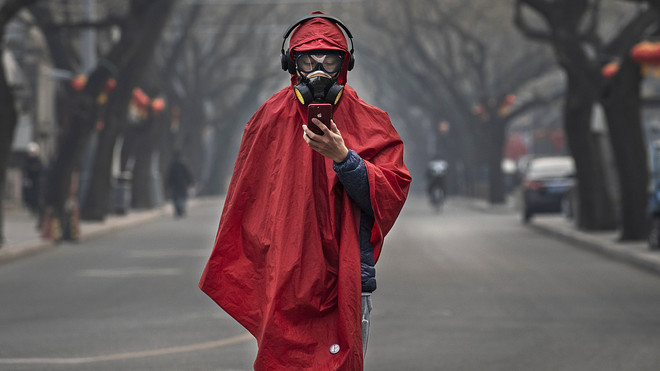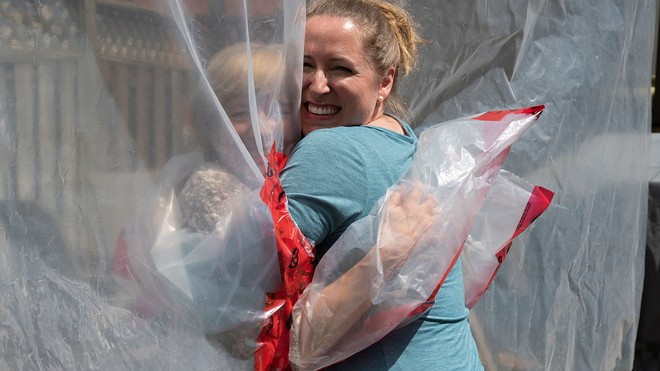Up until she fell ill with COVID-19, Yvonne Cassidy, a New York-based novelist, said she thought there were only three types of COVID: “The mild version, the version that put you in hospital and the version that killed you. I didn’t know there were others like me, stuck on a post-COVID plateau, not sick anymore, but not better either.”
Two months after being diagnosed with coronavirus, she found it difficult to even walk one block. “It turned out we were a group who had a name: We were COVID long-haulers. The Mayo Clinic and medical journals had published pieces about us,” she said. “We had support groups on social media. We even had a hashtag. We were frustrated and afraid.”
“With my doctor’s guidance I introduced a very slow five-minute jog into my already slow walking schedule. The first time I did it, my chest burned and I doubled over, hands on knees, gasping for breath,” Cassidy, who had toyed with training for a marathon, wrote in an essay for MarketWatch. And today? “The goal isn’t 26 miles. Today’s goal was 30 minutes.”
Cassidy was fortunate. Some younger COVID-19 patients who were otherwise healthy have had blood clots and strokes. Many “long-haulers” — COVID-19 patients who have continued showing symptoms for months after the initial infection — report neurological problems including confusion, difficulty concentrating, heart and lung issues, fatigue, insomnia, plus loss of taste and/or smell.
“There is evidence now that the virus can directly attack heart muscle cells, and there’s also evidence that the cytokine storm that the virus triggers in the body not only damages the lungs, but can damage the heart,” according to John Swartzberg, a clinical professor emeritus of infectious diseases and vaccinology in the the UC Berkeley-UCSF Joint Medical Program.
“One thing we didn’t anticipate was that the virus seems to accelerate a great deal of scarring in the lungs,” he said in an interview with the university. “What we really fear is long-term shortness of breath that could extend anywhere from being very mild to severely limiting.” He found it “disturbing” that one report of CT scans of asymptomatic patients were left with some scar tissue.
Some of these symptoms can persist for months, according to the Mayo Clinic. “The virus can damage the lungs, heart and brain, which increases the risk of long-term health problems.” Most people recover completely within a few weeks, “but some people — even those who had mild versions of the disease — continue to experience symptoms after their initial recovery,” it added.
“Older people and people with many serious medical conditions are the most likely to experience lingering COVID-19 symptoms,” the clinic added. “Although COVID-19 is seen as a disease that primarily affects the lungs, it can damage many other organs as well. This organ damage may increase the risk of long-term health problems.”

Yvonne Cassidy: ‘My chest burned and I doubled over, hands on knees, gasping for breath.’
Although COVID-19 patients can suffer long-term lung and heart damage, there is some good news for these long haulers. There’s more evidence that such aftereffects improve over time, according to a paper by a team of researchers presented at the European Respiratory Society International Congress, which studied patients in a COVID-19 “hot spot” in the Tyrolean region of Austria.
Some 86 patients out of a sample of 150 people were scheduled to return for evaluation 6, 12 and 24 weeks after their discharge from hospital. During these visits, clinical examinations, laboratory tests, arterial blood analysis of oxygen and carbon dioxide, lung function tests, computed tomography scans and echocardiograms (on the heart’s chambers and valves) were carried out.
At the time of their first visit, more than half of the patients had at least one persistent symptom, predominantly breathlessness and coughing, and computer tomography or CT scans showed lung damage in 88% of patients. However, by week 12 after discharge, symptoms improved and lung damage was reduced to 56%.
“ ‘The good news is that the impairment tends to ameliorate over time, which suggests the lungs have a mechanism for repairing themselves.’ ”
“The bad news is that people show lung impairment from COVID-19 weeks after discharge; the good news is that the impairment tends to ameliorate over time, which suggests the lungs have a mechanism for repairing themselves,” said Sabina Sahanic, a clinical Ph.D student at the University Clinic in Innsbruck and part of the team that carried out the study.
The average age of the 86 patients was 61 and 65% of them were male. Unlike Cassidy, nearly half of them were current or former smokers and 65% of hospitalized COVID-19 patients were overweight or obese. Eighteen (21%) had been in an intensive care unitÜ, 16 (19%) underwent invasive mechanical ventilation, and the average length of stay in hospital was 13 days.
The CT scans indicated that overall lung damage decreased from week 6 to week 12. Damage from inflammation and fluid in the lungs caused by COVID-19 was present in 74 patients (88%) at 6 weeks and 48 patients (56%) at 12 weeks. “We did not observe any severe coronavirus-associated heart dysfunction in the post-acute phase,” Sahanic said.
“The findings from this study show the importance of implementing structured follow-up care for patients with severe COVID-19 infection,” she added. “Importantly, CT unveiled lung damage in this patient group that was not identified by lung function tests. Knowing how patients have been affected long-term by the coronavirus might enable symptoms and lung damage to be treated much earlier.”

COVID-19 patients can suffer long-term lung and heart damage but, but there is some good news for these long haulers. (Photo: Getty Images)
This study is also supported by an article for primary-care physicians that was published last month in the British Medical Journal. It said that around 10% of patients who have tested positive for SARS-CoV-2 remain unwell beyond three weeks, and a smaller proportion for months. This was based on a study in which people log their ongoing symptoms on a smartphone app.
This percentage, however, is lower than that cited in many published observational studies. A recent U.S. study found that only 65% of people had returned to their previous level of health 14 to 21 days after a positive test, which has been the case with people who like Yvonne Cassidy who no longer have the virus, but have the antibodies.
Dr. Dixie Harris, a pulmonologist at the Intermountain Healthcare hospital system in Utah, told MarketWatch that coronavirus long haulers suffer shortness of breath, fatigue, memory issues, and even depression, but she too said there is “improvement over time.” She added, “Things such as prolonged symptoms — fatigue, that kind of thing — [have] been reported in MERS and SARS.”
In a second presentation to the European Respiratory Society International Congress on Monday, Yara Al Chikhanie, a Ph.D student at the Dieulefit Santé clinic for pulmonary rehabilitation and the Hp2 Lab at the Grenoble Alps University, France, said that the sooner COVID-19 patients started a pulmonary rehabilitation program after coming off ventilators, the better and faster their recovery.
She studied 19 patients who had spent an average of 3 weeks in intensive care and 2 weeks in a pulmonary ward before being transferred to the Dieulefit Santé clinic. The lack of physical movement in addition to severe infection and inflammation, lead to severe muscle loss, she said. The muscles for breathing are also affected. Most were unable to walk when they arrived at the clinic.
They underwent a test to see how far they could walk in six minutes. At the beginning, they were only able to walk barely a fifth of that distance on average, but after three weeks of pulmonary rehabilitation, this increased to an average of 43%. That is obviously still far from normal, but supervised rehabilitation helped to increase their lung capacity.
“ ‘The sooner rehabilitation started and the longer it lasted, the faster and better was the improvement in patients’ walking and breathing capacities and muscle gain.’ ”
“The sooner rehabilitation started and the longer it lasted, the faster and better was the improvement in patients’ walking and breathing capacities and muscle gain,” Al Chikhanie said. “Patients who started rehabilitation in the week after coming off their ventilators progressed faster than those who were admitted after 2 weeks.”
COVID-19 has now killed at least 890,064 people worldwide, and 189,114 in the U.S., Johns Hopkins University says. As of Labor Day, the U.S. still has the world’s highest number of COVID-19 cases (6,292,206). Worldwide, there have been at least 27,208,206 confirmed cases, which mostly does not account for asymptomatic cases.
AstraZeneca AZN, -1.07% , in combination with Oxford University; BioNTech SE BNTX, -1.19% and partner Pfizer PFE, -0.11% ; Johnson & Johnson JNJ, -0.64% ; Merck & Co. MERK, -3.84% ; Moderna MRNA, -3.45% ; and Sanofi SAN, +5.09% with GlaxoSmithKline GSK, -1.38% are among those currently working toward COVID-19 vaccines.
The Dow Jones Industrial Index DJIA, -0.56%, the S&P 500 SPX, -0.81% and the Nasdaq Composite COMP, -1.26% ended lower Friday. Doubts about traction for further fiscal stimulus from Washington may be one factor discouraging investors who have been betting on Republicans and Democrats striking a deal to offer additional relief to consumers and businesses.
India has reported 4,204,613 COVID-19 cases, surpassing Brazil (with 4,137,521) as the country with the second highest number of coronavirus cases in the world behind the U.S. India has a rate of COVID-related death per 100,000 people of 5.3 and a case-fatality rate of 1.7%. In contrast, the U.S. has a fatality rate of 57.7 per 100,000 people and a case-fatality rate of 3%.






